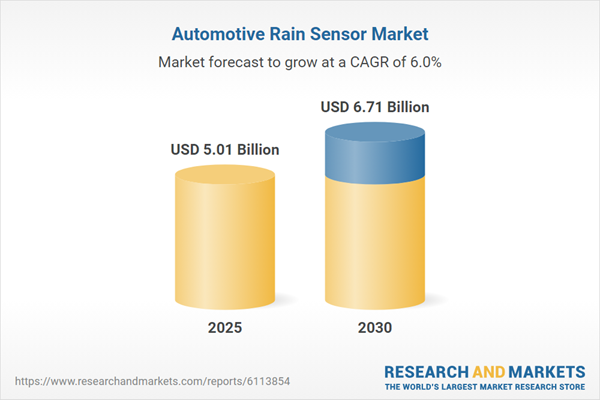Automotive rain sensors are advanced devices that automatically detect raindrops on a vehicle’s windshield, activating wipers and adjusting their speed based on rainfall intensity. These sensors enhance driver safety and convenience by improving visibility and reducing the need for manual wiper operation. The market for automotive rain sensors is driven by increasing vehicle automation, a growing Original Equipment Manufacturer (OEM) sector, and rising demand for electric vehicles (EVs) and eco-friendly vehicles, spurred by heightened environmental awareness.
Market Trends
The automotive rain sensor market is experiencing growth due to the increasing automation of vehicles, which integrates advanced technologies like rain sensors to improve functionality. The expanding OEM market significantly contributes to this growth, as OEMs produce components tailored to automotive manufacturers’ specifications. The surge in demand for EVs and eco-friendly vehicles, driven by global climate change concerns, is a key factor propelling the market. Stringent regulations in regions like North America and Europe, where policies aim to reduce carbon emissions, further bolster the adoption of rain sensors in these vehicles. For instance, Britain’s target of net-zero emissions by 2050 includes a ban on new petrol and diesel car sales from 2030, while the European Union and California have set similar bans starting in 2035. These regulations drive the integration of advanced technologies in eco-friendly vehicles, positively impacting the rain sensor market. The Asia Pacific region is poised for substantial growth due to rising populations and increasing disposable incomes, which fuel demand for advanced vehicle features.Growth Factors
The rise in EV and eco-friendly vehicle adoption is a primary growth driver for the automotive rain sensor market. As nations implement stricter environmental policies, such as bans on fossil-fuel vehicles, the demand for vehicles equipped with advanced features like rain sensors increases. The OEM sector plays a critical role, supplying components that align with the growing production of EVs. Additionally, rising disposable incomes, improved infrastructure, and the availability of low-cost vehicles have shifted consumer preferences toward personal transportation, further supporting the integration of rain sensors. The trend of automation in the automotive industry and the emergence of innovative car rental startups also contribute to market growth by increasing demand for advanced vehicle components.Market Restraints
A key restraint for the automotive rain sensor market is its relevance primarily in regions prone to rainfall. In areas with low precipitation, such as the Middle East and North Africa (e.g., Qatar, Saudi Arabia, UAE, Kuwait, and Egypt), the need for rain sensors is minimal, limiting market penetration. Additionally, the integration of rain sensors increases vehicle production costs, which may deter adoption in price-sensitive markets.Regional Insights
North America and Europe dominate the market due to stringent environmental regulations and high adoption of advanced vehicle technologies. The Asia Pacific region, however, is expected to see significant growth, driven by population growth, rising incomes, and increasing demand for automated vehicle features.Key Benefits of this Report:
- Insightful Analysis: Gain detailed market insights covering major as well as emerging geographical regions, focusing on customer segments, government policies and socio-economic factors, consumer preferences, industry verticals, and other sub-segments.
- Competitive Landscape: Understand the strategic maneuvers employed by key players globally to understand possible market penetration with the correct strategy.
- Market Drivers & Future Trends: Explore the dynamic factors and pivotal market trends and how they will shape future market developments.
- Actionable Recommendations: Utilize the insights to exercise strategic decisions to uncover new business streams and revenues in a dynamic environment.
- Caters to a Wide Audience: Beneficial and cost-effective for startups, research institutions, consultants, SMEs, and large enterprises.
What do businesses use our reports for?
Industry and Market Insights, Opportunity Assessment, Product Demand Forecasting, Market Entry Strategy, Geographical Expansion, Capital Investment Decisions, Regulatory Framework & Implications, New Product Development, Competitive IntelligenceReport Coverage:
- Historical data from 2022 to 2024 & forecast data from 2025 to 2030
- Growth Opportunities, Challenges, Supply Chain Outlook, Regulatory Framework, and Trend Analysis
- Competitive Positioning, Strategies, and Market Share Analysis
- Revenue Growth and Forecast Assessment of segments and regions including countries
- Company Profiling (Strategies, Products, Financial Information, and Key Developments among others).
By Installation Type
- Original Equipment Manufacturer (OEM)
- Aftermarket
By Vehicle Type
- Passenger Vehicles
- Commercial Vehicles
- Light Commercial Vehicles
- Heavy Commercial Vehicles
By Geography
- North America
- USA
- Canada
- Mexico
- South America
- Brazil
- Argentina
- Others
- Europe
- Germany
- France
- United Kingdom
- Spain
- Others
- Middle East and Africa
- Israel
- Saudi Arabia
- Others
- Asia Pacific
- China
- Japan
- South Korea
- India
- Others
Table of Contents
Companies Mentioned
- Denso Corporation
- Forvia
- Melexis (Xtrion N.V)
- KOSTAL Automobil Elektrik GmbH & Co. KG
- Valeo
- Amphenol Corporation
- Onsemi
- Hamamatsu Photonics
Table Information
| Report Attribute | Details |
|---|---|
| No. of Pages | 147 |
| Published | June 2025 |
| Forecast Period | 2025 - 2030 |
| Estimated Market Value ( USD | $ 5.01 Billion |
| Forecasted Market Value ( USD | $ 6.71 Billion |
| Compound Annual Growth Rate | 6.0% |
| Regions Covered | Global |
| No. of Companies Mentioned | 8 |









